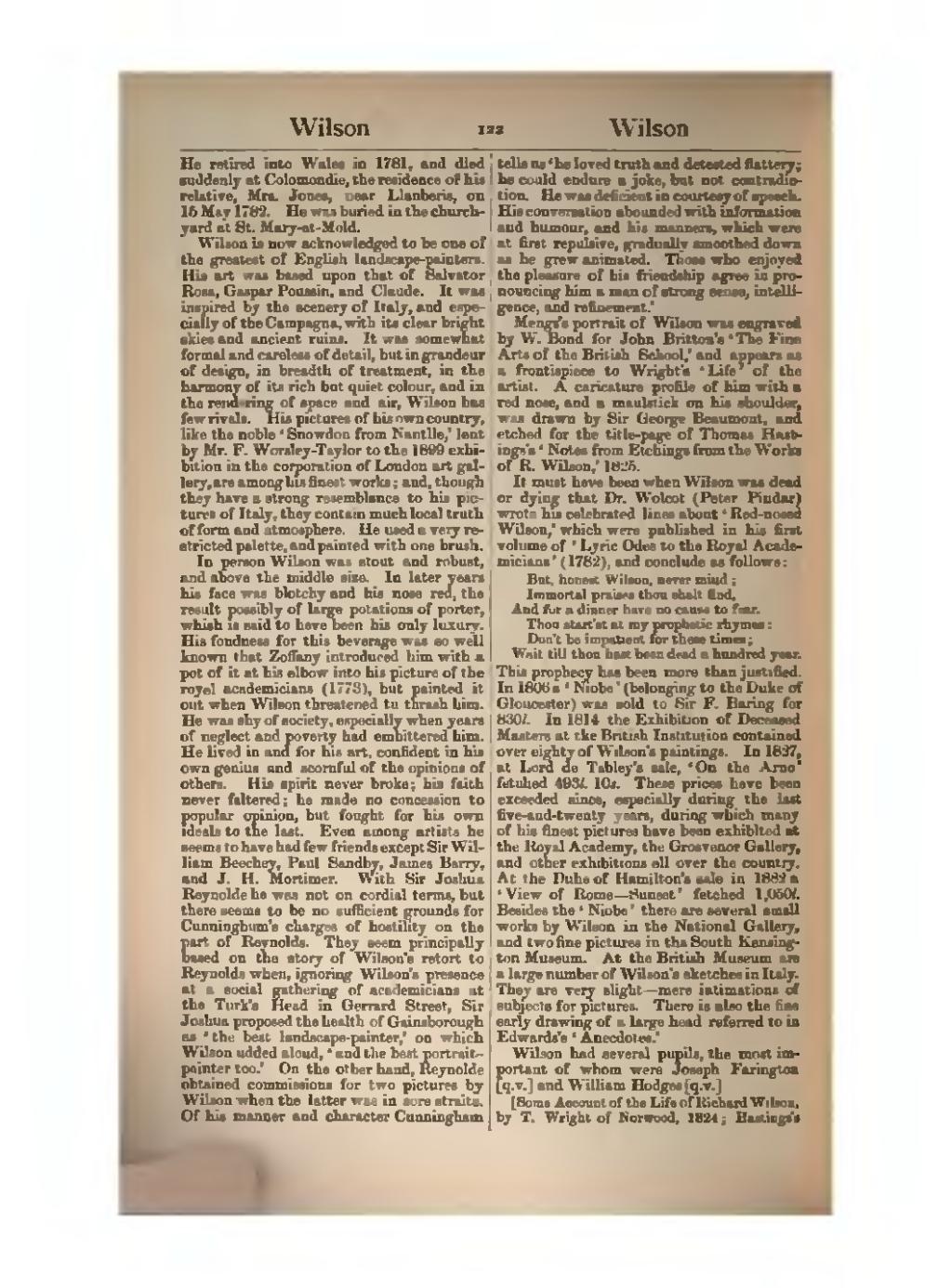He retired into Wales in 1781, and died suddenly at Colomondie, the residence of his relative, Mrs. Jones, near Llanberis, on 15 May 1782. He was buried in the churchyard at St. Mary-at-Mold.
Wilson is now acknowledged to be one of the greatest of English landscape-painters. His art was based upon that of Salvator Rosa, Gaspar Poussin, and Claude. It was inspired by the scenery of Italy, and especially of the Campagna, with its clear bright skies and ancient ruins. It was somewhat formal and careless of detail, but in grandeur of design, in breadth of treatment, in the harmony of its rich but quiet colour, and in the rendering of space and air, Wilson has few rivals. His pictures of his own country, like the noble ‘Snowdon from Nantlle,’ lent by Mr. F. Worsley-Taylor to the 1899 exhibition in the corporation of London art gallery, are among his finest works; and, though they have a strong resemblance to his pictures of Italy, they contain much local truth of form and atmosphere. He used a very restricted palette, and painted with one brush.
In person Wilson was stout and robust, and above the middle size. In later years his face was blotchy and his nose red, the result possibly of large potations of porter, which is said to have been his only luxury. His fondness for this beverage was so well known that Zoffany introduced him with a pot of it at his elbow into his picture of the royal academicians (1773), but painted it out when Wilson threatened to thrash him. He was shy of society, especially when years of neglect and poverty had embittered him. He lived in and for his art, confident in his own genius and scornful of the opinions of others. His spirit never broke; his faith never faltered; he made no concession to popular opinion, but fought for his own ideals to the last. Even among artists he seems to have had few friends except Sir William Beechey, Paul Sandby, James Barry, and J. H. Mortimer. With Sir Joshua Reynolds he was not on cordial terms, but there seems to be no sufficient grounds for Cunningham's charges of hostility on the part of Reynolds. They seem principally based on the story of Wilson's retort to Reynolds when, ignoring Wilson's presence at a social gathering of academicians at the Turk's Head in Gerrard Street, Sir Joshua proposed the health of Gainsborough as ‘the best landscape-painter,’ on which Wilson added aloud, ‘and the best portrait-painter too.’ On the other hand, Reynolds obtained commissions for two pictures by Wilson when the latter was in sore straits. Of his manner and character Cunningham tells us ‘he loved truth and detested flattery; he could endure a joke, but not contradiction. He was deficient in courtesy of speech. His conversation abounded with information and humour, and his manners, which were at first repulsive, gradually smoothed down as he grew animated. Those who enjoyed the pleasure of his friendship agree in pronouncing him a man of strong sense, intelligence, and refinement.’
Mengs's portrait of Wilson was engraved by W. Bond for John Britton's ‘The Fine Arts of the British School, ’ and appears as a frontispiece to Wright's ‘Life’ of the artist. A caricature profile of him with a red nose, and a maulstick on his shoulder, was drawn by Sir George Beaumont, and etched for the title-page of Thomas Hastings's ‘Notes from Etchings from the Works of R. Wilson,’ 1825.
It must have been when Wilson was dead or dying that Dr. Wolcot (Peter Pindar) wrote his celebrated lines about ‘Red-nosed Wilson,’ which were published in his first volume of ‘Lyric Odes to the Royal Academicians’ (1782), and conclude as follows:
But, honest Wilson, never mind;
Immortal praises thou shalt find,
And for a dinner have no cause to fear.
Thou start'st at my prophetic rhymes:
Don't be impatient for those times;
Wait till thou hast been dead a hundred year.
This prophecy has been more than justified. In 1806 a ‘Niobe’ (belonging to the Duke of Gloucester) was sold to Sir F. Baring for 830l. In 1814 the Exhibition of Deceased Masters at the British Institution contained over eighty of Wilson's paintings. In 1827, at Lord de Tabley's sale, ‘On the Arno’ fetched 493l. 10s. These prices have been exceeded since, especially during the last five-and-twenty years, during which many of his finest pictures have been exhibited at the Royal Academy, the Grosvenor Gallery, and other exhibitions all over the country. At the Duke of Hamilton's sale in 1882 a ‘View of Rome—Sunset’ fetched 1,050l. Besides the ‘Niobe’ there are several small works by Wilson in the National Gallery, and two fine pictures in the South Kensington Museum. At the British Museum are a large number of Wilson's sketches in Italy. They are very slight—mere intimations of subjects for pictures. There is also the fine early drawing of a large head referred to in Edwards's ‘Anecdotes.’
Wilson had several pupils, the most important of whom were Joseph Farington [q. v.] and William Hodges [q. v.]
[Some Account of the Life of Richard Wilson, by T. Wright of Norwood, 1824; Hastings's
